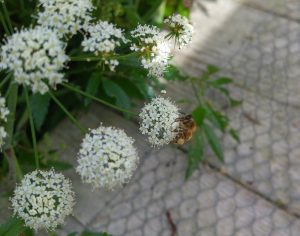July is here and with it comes the start of summer, seemingly. After a cold, wet, long spring we’ve had a good couple of days of warm sunshine and blue skies. Perhaps because it hasn’t had time to really settle in yet, it doesn’t actually feel like the hazy summers past, or perhaps that’s because I’m too impatient or nostalgic. Whatever the reason, I’m hoping for more of the same please. We’re definitely owed an elongated spell of good weather to enjoy iced coffee, iced tea and ice creams!
The wildlife on Hoveton Great Broad has seemingly been enjoying the clement spell also. As I arrived this morning I first noticed the bindweed had come out in a tumble of trumpet-shaped, linen-white flowers. Purple loosestrife and great willowherb had splashed pink across the multitudes of green on the fringes of the reedbeds, and the peculiar flowers of reedmace had begun to develop. The insects were taking full advantage of the emerging bounty, most notably the hoverflies which whined and buzzed around me as I walked along the trail.

I tried to capture some of these in a specimen bottle in order to identify them, but their reactions far outpaced mine and I was left frustrated and clueless as to the species that surrounded me. The alder flowers had largely dried up now, replaced by green berries, meaning the bees had to seek their source of nectar elsewhere, and they found it on the beautifully delicate and perfectly formed flowers of cowbane, like static fireworks along the sides of the dyke adjacent to the bridge that took me to Larkbush Island.
The mature alder woodland on the island shelters many bird species, and the juveniles are starting to build in confidence and find their feet after what must be quite a traumatic fledging experience. I encountered a young blackcap which didn’t seem to know what to make of me, but kept a safe distance nonetheless. Through the dappled light of the alder leaves a speckled wood butterfly sauntered across my path, alighting on a large hop leaf and posing for me in the sunshine. Continuing on my circular route I passed over the second bridge, leaving the island flanked by a guard of reed standing taller than me, occupying the dyke in poorly organised regiments. The thin patch of open water was abounding with black tailed skimmers looking smart in their blue and black finery, but destroying the illusion whenever they came to rest as they slouch their wings lazily and carelessly. There was no such rest for the other Odonata occupant of the dyke, the tireless Norfolk hawker. Large, gingery-brown, with bright green eyes polished to a sheen, patrolling up and down the waterway like a sergeant, agitating the skimmers into action. And as I arrived back at the moorings I heard the distinctive and indistinguishable mewlings of a buzzard, riding the thermals high in the blue sky, above the clouds that pockmarked that watercolour canvas.
The saying goes that one swallow does not a summer make, and in a similar fashion I am not expecting this single sunny day to turn into the halcyon days of July, August and September like the ones in my rose-tinted, pollen-filled, long-evening memories. But nonetheless, as we leave midsummer behind I expect the days to warm as they shorten, and for summer to finally wake up and stretch to its fingertips before the headlong tumble into autumn and winter. Best go make some hay!
